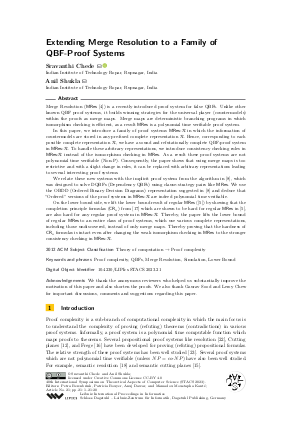@InProceedings{chede_et_al:LIPIcs.STACS.2023.21,
author = {Chede, Sravanthi and Shukla, Anil},
title = {{Extending Merge Resolution to a Family of QBF-Proof Systems}},
booktitle = {40th International Symposium on Theoretical Aspects of Computer Science (STACS 2023)},
pages = {21:1--21:20},
series = {Leibniz International Proceedings in Informatics (LIPIcs)},
ISBN = {978-3-95977-266-2},
ISSN = {1868-8969},
year = {2023},
volume = {254},
editor = {Berenbrink, Petra and Bouyer, Patricia and Dawar, Anuj and Kant\'{e}, Mamadou Moustapha},
publisher = {Schloss Dagstuhl -- Leibniz-Zentrum f{\"u}r Informatik},
address = {Dagstuhl, Germany},
URL = {https://drops.dagstuhl.de/entities/document/10.4230/LIPIcs.STACS.2023.21},
URN = {urn:nbn:de:0030-drops-176737},
doi = {10.4230/LIPIcs.STACS.2023.21},
annote = {Keywords: Proof complexity, QBFs, Merge Resolution, Simulation, Lower Bound}
}

 Creative Commons Attribution 4.0 International license
Creative Commons Attribution 4.0 International license


